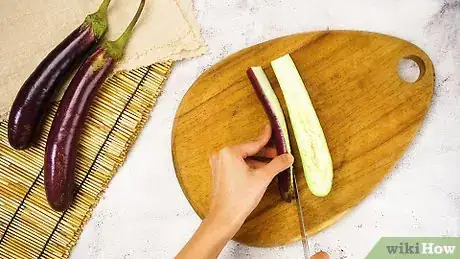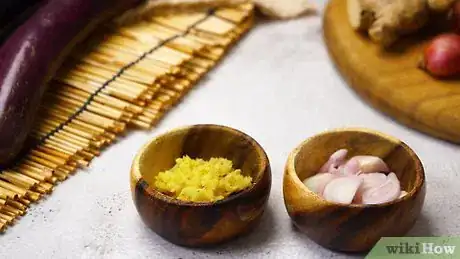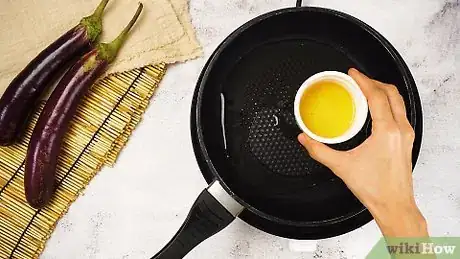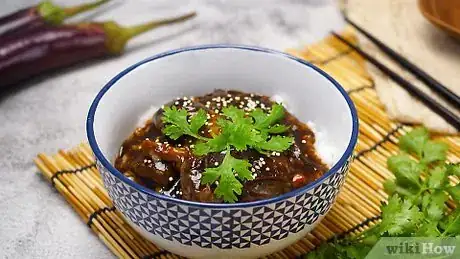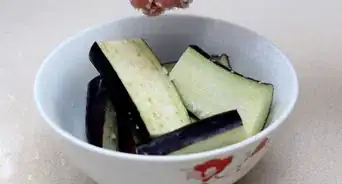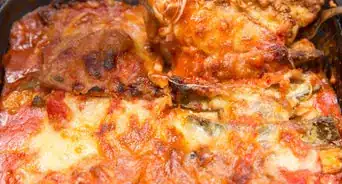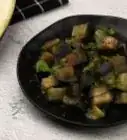This article was co-authored by wikiHow Staff. Our trained team of editors and researchers validate articles for accuracy and comprehensiveness. wikiHow's Content Management Team carefully monitors the work from our editorial staff to ensure that each article is backed by trusted research and meets our high quality standards.
There are 10 references cited in this article, which can be found at the bottom of the page.
The wikiHow Culinary Team also followed the article's instructions and verified that they work.
This article has been viewed 16,308 times.
Learn more...
Japanese eggplants are sweet, delicate, tasty eggplants famously used in all types of Asian cuisines. They cook quickly because they’re on the smaller side, and they’re delicious when paired with other fresh ingredients, like ginger, green onion, cilantro, and garlic. If you see these eggplants at your local grocery store or farmer’s market, buy a handful and try making one of these dishes!
Ingredients
Grilled Eggplant
- 4 Japanese eggplants
- 1⁄4 cup (59 mL) of soy sauce
- 1⁄4 cup (59 mL) of dry sherry
- 2 tablespoons (30 mL) of sesame oil
- 3 cloves of minced garlic
- 2 tbsp (18 grams) of toasted sesame seeds
- Salt and pepper
Makes 4 servings
Broiled Eggplant
- 2 Japanese eggplants
- 2 sliced scallions
- Katsuobushi flakes for seasoning
- 1⁄2 inch (1.3 cm) knob of ginger, grated
- Soy sauce for serving
Makes 2 servings
Stir-Fried Eggplant
- 5 Japanese eggplants
- 3 tablespoons (44 mL) of peanut oil
- 1 tablespoon (15 mL) of sesame oil
- Salt and pepper
- 2 sliced green onions
- 1 inch (2.5 cm) knob of ginger, minced
- 3 minced garlic cloves
- 1 sliced red chili
- 1⁄2 cup (120 mL) of chicken broth
- 3 tablespoons (44 mL) of soy sauce
- 1 tablespoon (15 mL) of rice vinegar
- 1 tbsp (12.5 grams) of brown sugar
- 1 tbsp (7.5 grams) of cornstarch
- 1 tbsp (9 grams) of toasted sesame seeds
- Cilantro for garnishing
Makes 4 servings
Steps
Grilling
-
1Slice each eggplant in half lengthwise. Chop the stem off of each eggplant. Then, carefully slice each eggplant in half on a cutting board with a clean chef’s knife.[1]
- Japanese eggplants are usually straight, unlike their curved Italian cousins. They have thin skin and are easy to slice, so be careful not to cut yourself.[2]
-
2Marinate the eggplant in the soy sauce, sherry, and garlic for 1 hour. In a small bowl, stir together 1⁄4 cup (59 mL) of soy sauce, 1⁄4 cup (59 mL) of dry sherry, and 2 tablespoons (30 mL) of sesame oil. Put the sliced eggplant into a shallow baking dish, then pour the marinade over top. Let the eggplant rest for 1 hour at room temperature.[3]
- Feel free to substitute low-sodium soy sauce if you prefer!
- If you don’t have dry sherry, use rice wine or rice vinegar instead.[4]
- This is a great time to prep the other components to your meal.
Advertisement -
3Set your grill to medium-high heat and let it warm up. If the grill grates are dirty from the last time you used them, scrape them clean so the char doesn’t get onto your eggplant.[5]
- Don’t forget, you can grill Japanese eggplant alongside other delicious veggies. Yellow squash, zucchini, mushrooms, asparagus, and tomatoes take about the same amount of time as Japanese eggplants.
-
4Remove the eggplant from the marinade and season it with salt and pepper. Set the halved eggplants on a plate; sprinkle both sides of each piece with a dash of salt and pepper. You can always add more once the dish is finished if it needs it.[6]
- Adding salt and pepper is entirely optional. If you are concerned about how much sodium is in your diet, leave off the salt entirely, or just add a pinch after the eggplant is grilled.
-
5Grill the eggplant for 3 minutes, occasionally basting it with the marinade. Lay the eggplant in a single layer across the hot section of the grill. Leave about 1 inch (2.5 cm) of space between each piece so the heat can evenly get around the edges. Every minute, use a basting or pastry brush to cover the eggplant with more marinade.[7]
- Adding marinade as the eggplant cooks gives it more flavor.
-
6Flip the eggplant over and grill it for 3 additional minutes. Use a pair of tongs to turn over each piece of eggplant carefully. Continue to baste the eggplant with marinade to make sure each piece is as flavorful as possible.[8]
- Be careful not to burn yourself on the grill.
-
7Remove the eggplant from the grill and top it with toasted sesame seeds. Use a pair of tongs to take the eggplant off the rack and set it on a plate or bowl. Sprinkle it with 2 tbsp (18 grams) of toasted sesame seeds.[9]
- You could also add 2 tbsp (12 grams) of sliced scallions to impart more flavor.
- If you don’t have toasted sesame seeds, you can make your own! Cook them in a dry skillet over medium heat until they turn brown, about 3-5 minutes.
Broiling
-
1Move an oven rack to the top shelf and preheat the broiler. Because Japanese eggplant is smaller, thinner, and more delicate than regular eggplant, it takes just a few minutes to broil under high heat. This entire dish will be finished within 10 minutes from beginning to end.[10]
- Moving the oven rack close to the top exposes the eggplant to more direct heat, meaning it’ll cook through and brown quicker.
-
2Score the eggplants around their tops and bottoms and along their lengths. Use a sharp chef’s knife to carefully cut a circle around the stem and the eggplant base, just deep enough to pierce the skin. Make 3 short diagonal slashes along the length of each eggplant.[11]
- Scoring the eggplant will help its skin come off more easily after it has been broiled.
-
3Broil the eggplants on each side for 3-4 minutes. Place the eggplants on a wire rack set over top of a sheet pan so they’re even closer to the broiler, which will give them a better char. Then, put the sheet pan in the oven on the top shelf. After the initial 3-4 minutes, check that the skin is getting darker and starting to char. Flip the eggplants over with a pair of tongs and cook them for another 3-4 minutes.[12]
- Toward the end, prod the eggplants with your finger. The meat should give a little bit without feeling mushy.
-
4Mince the ginger and slice the scallions while the eggplant is broiling. Use a 1⁄2 in (1.3 cm) knob of ginger and 2 scallions. With your chef’s knife, cut the scallions into thin rounds, discarding the dark green ends and roots. For the ginger, slice the knob into thin rounds, then cut them into strips; finally, dice the strips crosswise to create small minced bits.[13]
- The ginger and scallions garnish the eggplant, so prepare more if you enjoy these ingredients. You can always save leftovers in the fridge.
-
5Let the eggplant cool for a few minutes, then peel off the skin. Remove the pan from the oven and set it somewhere safe. Start peeling at the top of the eggplant where you scored it—the skin should come away quickly. Be careful not to burn your fingers—the eggplant might still be quite hot.[14]
- The hotter the eggplant, the easier it’ll be to peel. But, use your best judgment so you don’t hurt yourself.
-
6Slice the eggplant into 1⁄2 inch (1.3 cm) pieces. Use a clean knife and cutting board to cut the eggplant carefully. Divide the pieces between 2 plates.[15]
- You could also put all the pieces onto a single plate and serve them as appetizers before a bigger meal.
-
7Serve the eggplant with the scallions, ginger, katsuobushi, and soy sauce. Top each piece of eggplant with a little bit of everything and enjoy! Use a spoon to drizzle some soy sauce over each piece before you eat it. [16]
- Find katsuobushi at Asian supermarkets, Japanese markets, or online. These large smokey flakes are made from fermented fish and add a savory element to the dish. Their flavor is reminiscent of anchovies and bacon, though it’s a very light seasoning. They’re also sometimes called bonito flakes.
Stir-Frying
-
1Halve the eggplants lengthwise, then cut them into 1 in (2.5 cm) pieces. Do your best to make each piece the same size, so they’ll cook through evenly. There’s no need to peel the eggplant—the skin of a Japanese eggplant is thin and easy to bite through.[17]
- Be careful not to cut your fingers while slicing the eggplant.
-
2Heat the peanut oil and sesame oil in a skillet over medium-high heat. Use 3 tablespoons (44 mL) of peanut oil and 1 tablespoon (15 mL) of sesame oil. Tilt the skillet back and forth so that the oil evenly coats the bottom of the pan.[18]
- This is a great recipe to try using a wok, if you have one!
-
3Cook a layer of eggplant in the hot skillet for about 3 minutes. Once you see some smoke coming from the hot oils, go ahead and put a single layer of eggplant over the skillet's bottom. Toss and stir the eggplant so it gets cooked on all sides and starts to brown and get sticky. Remove it from the pan when it’s done.[19]
- If you couldn’t fit all the eggplant in one go, work in batches. Set cooked eggplant to the side on a clean plate and continue stir-frying the rest of the eggplant until it’s all done.
-
4Saute the green onions, ginger, garlic, and chili for 1-2 minutes. Add 2 sliced green onions, 1 inch (2.5 cm) knob of minced ginger, 3 cloves of minced garlic, and 1 sliced red chili to the hot skillet. Stir them back and forth until they become aromatic.[20]
- Using the same skillet for everything means you won’t have as many dishes to clean up afterward.
-
5Pour 1⁄2 cup (120 mL) of chicken broth into the skillet. Measure the liquid and carefully pour it into the skillet. Watch out for the steam that’ll form when it hits the hot pan.[21]
- If you don’t have chicken broth, you could also use vegetable or beef broth.
-
6Mix the soy sauce, vinegar, sugar, and cornstarch in a small bowl. Use 3 tablespoons (44 mL) of soy sauce, 1 tablespoon (15 mL) of rice vinegar, 1 tbsp (12.5 grams) of brown sugar, and 1 tbsp (7.5 grams) of cornstarch. Stir them together vigorously until the sugar and cornstarch have completely dissolved.[22]
- Use either a fork or a whisk to help the sugar and cornstarch dissipate more thoroughly.
-
7Add the ingredients from the bowl to the skillet and cook for 1-2 minutes. Observe the sauce so you see when it starts to thicken. Once it’s developed enough to stick to the back of a spoon, you’re ready to move on to the next step.[23]
- It’s okay if it takes a few extra minutes for the sauce to thicken. Just keep an eye on it and stir it occasionally so nothing burns to the bottom of the skillet.
-
8Return the eggplant to the skillet and mix everything together. The eggplant is pretty porous and will absorb the sauce you just made. Use a wooden spoon or tongs to toss the eggplant so that it’s coated on every side.[24]
- This step also reheats the eggplant so it’s pleasantly warm.
-
9Top the stir-fried eggplant with toasted sesame seeds and fresh cilantro. Use about 1 tbsp (9 grams) of sesame seeds and as much cilantro as you like. Enjoy the dish while it’s still hot![25]
- Consider serving your stir-fried eggplant with warm rice.
Warnings
- Wear oven mitts when taking things out of the oven so you don’t burn your hands.⧼thumbs_response⧽
- Always use caution when cooking on a grill or stovetop.⧼thumbs_response⧽
Things You’ll Need
Grilling
- Chef’s knife
- Cutting board
- Small bowl
- Spoon
- Measuring cups and spoons
- Shallow baking dish
- Pair of tongs
- Plate
- Basting or pastry brush
Broiling
- Chef’s knife
- Cutting board
- Wire rack
- Sheet pan
- Oven mitts
- Plates
- Small bowls for soy sauce
- Pair of tongs
Stir-Frying
- Chef’s knife
- Cutting board
- Wok or skillet
- Measuring cups and spoons
- Plate
- Wooden spoon
- Small bowl
References
- ↑ https://www.thekitchn.com/grilled-vegetables-268369
- ↑ https://www.epicurious.com/ingredients/types-of-asian-vegetables-and-produce-article
- ↑ https://www.foodnetwork.com/recipes/bobby-flay/grilled-japanese-eggplant-recipe-1949999
- ↑ https://www.seriouseats.com/recipes/2009/07/grilling-chinese-eggplant-garlic-ginger-recipe.html
- ↑ https://www.thekitchn.com/grilled-vegetables-268369
- ↑ https://www.foodnetwork.com/recipes/bobby-flay/grilled-japanese-eggplant-recipe-1949999
- ↑ https://www.foodnetwork.com/recipes/bobby-flay/grilled-japanese-eggplant-recipe-1949999
- ↑ https://www.foodnetwork.com/recipes/bobby-flay/grilled-japanese-eggplant-recipe-1949999
- ↑ https://www.foodnetwork.com/recipes/bobby-flay/grilled-japanese-eggplant-recipe-1949999
- ↑ https://www.seriouseats.com/recipes/2018/07/japanese-style-broiled-eggplant-with-bonito-scallions-and-ginger.html
- ↑ https://www.seriouseats.com/recipes/2018/07/japanese-style-broiled-eggplant-with-bonito-scallions-and-ginger.html
- ↑ https://www.seriouseats.com/recipes/2018/07/japanese-style-broiled-eggplant-with-bonito-scallions-and-ginger.html
- ↑ https://www.thekitchn.com/how-to-peel-and-mince-fresh-ginger-cooking-lessons-from-the-kitchn-182774
- ↑ https://www.seriouseats.com/recipes/2018/07/japanese-style-broiled-eggplant-with-bonito-scallions-and-ginger.html
- ↑ https://www.seriouseats.com/recipes/2018/07/japanese-style-broiled-eggplant-with-bonito-scallions-and-ginger.html
- ↑ https://www.seriouseats.com/recipes/2018/07/japanese-style-broiled-eggplant-with-bonito-scallions-and-ginger.html
- ↑ https://www.foodnetwork.com/recipes/tyler-florence/szechwan-eggplant-stir-fry-recipe-1941507
- ↑ https://www.foodnetwork.com/recipes/tyler-florence/szechwan-eggplant-stir-fry-recipe-1941507
- ↑ https://www.foodnetwork.com/recipes/tyler-florence/szechwan-eggplant-stir-fry-recipe-1941507
- ↑ https://www.foodnetwork.com/recipes/tyler-florence/szechwan-eggplant-stir-fry-recipe-1941507
- ↑ https://www.foodnetwork.com/recipes/tyler-florence/szechwan-eggplant-stir-fry-recipe-1941507
- ↑ https://www.foodnetwork.com/recipes/tyler-florence/szechwan-eggplant-stir-fry-recipe-1941507
- ↑ https://www.foodnetwork.com/recipes/tyler-florence/szechwan-eggplant-stir-fry-recipe-1941507
- ↑ https://www.foodnetwork.com/recipes/tyler-florence/szechwan-eggplant-stir-fry-recipe-1941507
- ↑ https://www.foodnetwork.com/recipes/tyler-florence/szechwan-eggplant-stir-fry-recipe-1941507
- ↑ https://www.epicurious.com/ingredients/types-of-asian-vegetables-and-produce-article
- ↑ https://www.epicurious.com/ingredients/how-to-buy-eggplant-varieties-article
- ↑ https://www.thekitchn.com/a-visual-guide-to-10-glorious-varieties-of-eggplant-232828
- ↑ https://www.thekitchn.com/recipe-baba-ghanoush-smoky-eggplant-dip-30084
